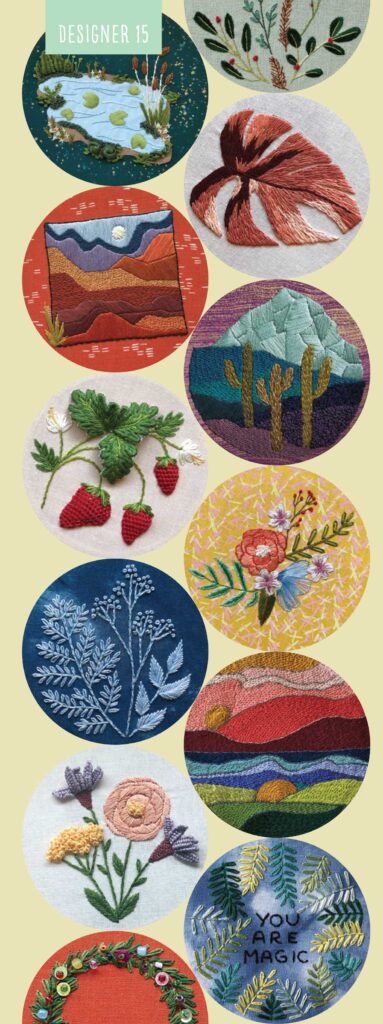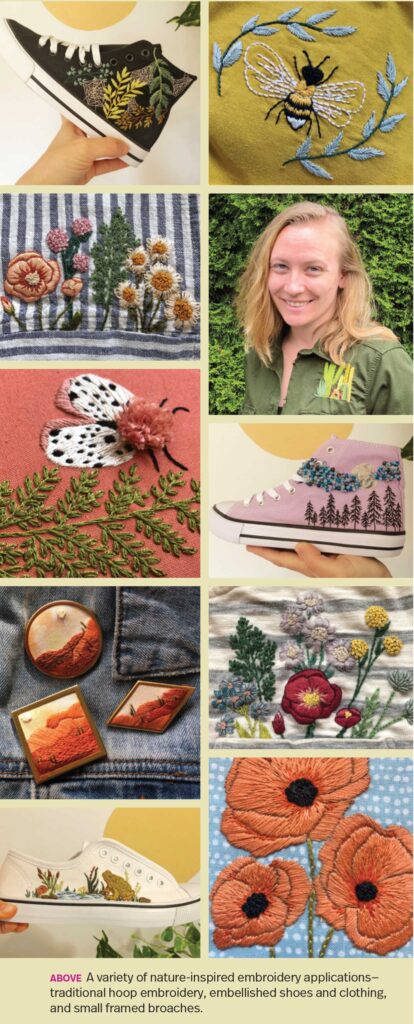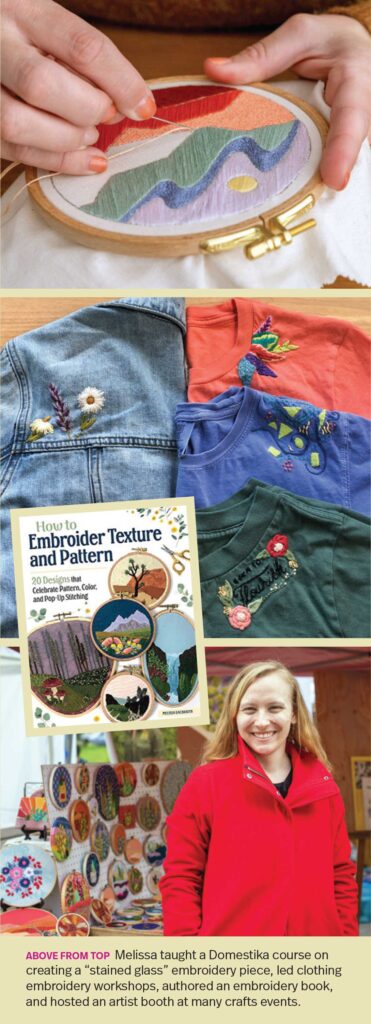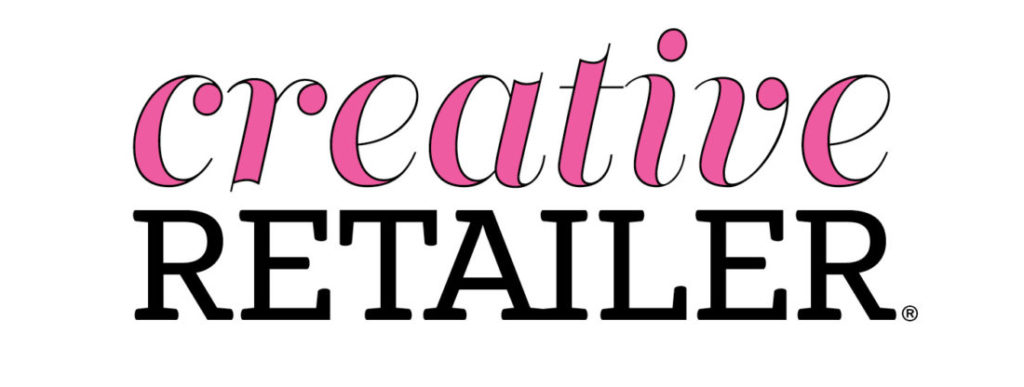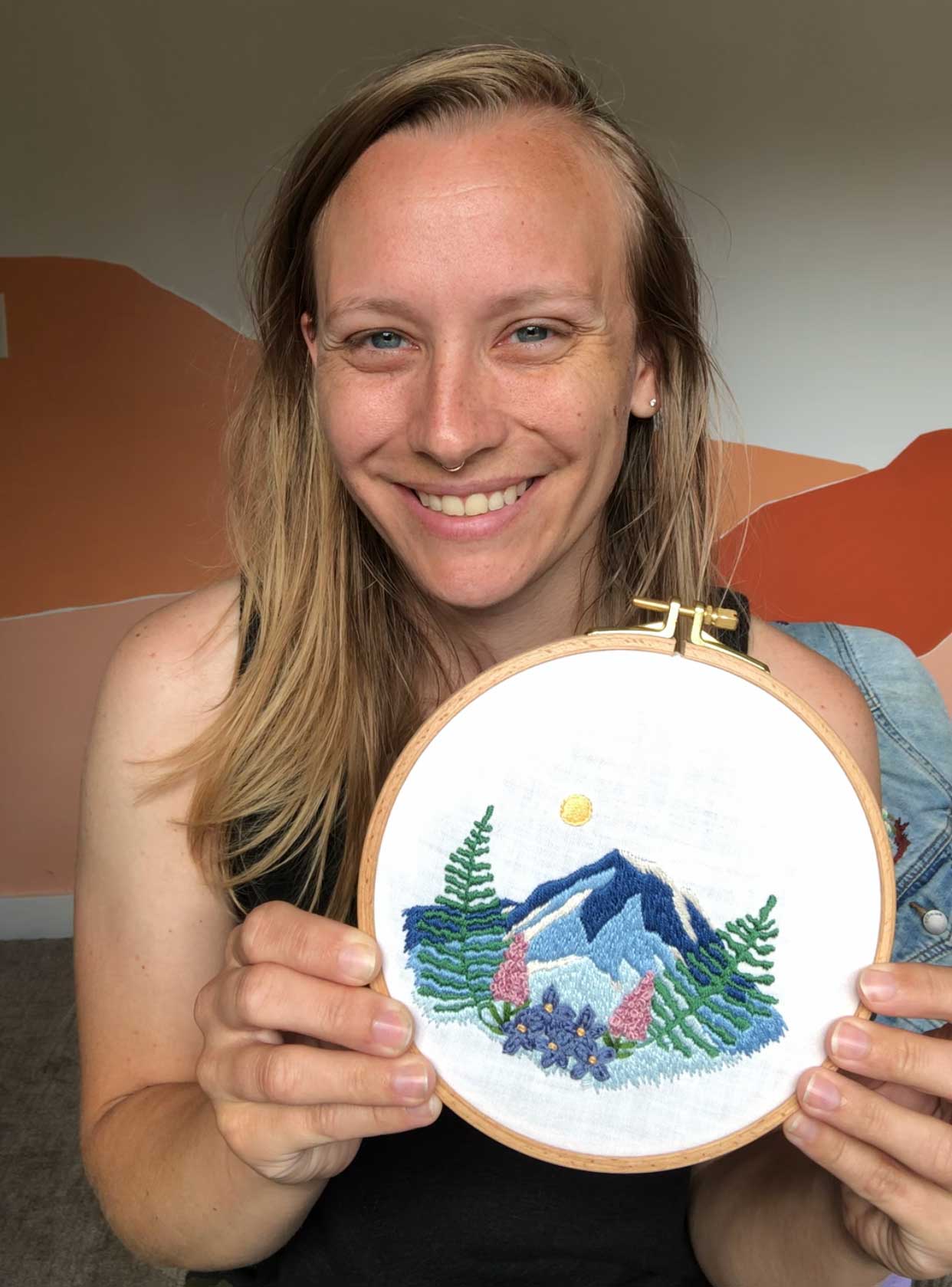Melissa Galbraith, MCreativeJ
Filling a need, modern embroidery patterns that become art.
Melissa Galbraith, the creative spirit behind MCreativeJ, which provides hand embroidery kits and patterns inspired by nature. Here she answers our questions about her interest in fiber art and her business.
WHAT DOES MODERN EMBROIDERY MEAN TO YOU? HOW DID YOU GET YOUR START?
I was lucky enough to grow up in a household that valued crafting and making things by hand. My mom, my sisters and I played around with many different mediums. From bobbin lace to papier-mâché and quilting to designing my own dresses for school dances, we did it all. Growing up, my mom helped me feel like I could try anything I set my mind to. One of the crafts I tried as a young kid was hand embroidery. Even at that age, the patterns felt dated and not all that exciting. I wanted a design I could relate to. While I didn’t stick with embroidery as a child—I was much more into coloring at that age—I found myself gravitating toward it again as an adult. For me, embroidery is like coloring with thread.
When I picked embroidery back up, I found that patterns at big-box stores hadn’t changed much since I was a kid. I couldn’t relate to them and didn’t really want to stitch them. Thanks to my mom, I felt like I could create my own designs and go from there. For me, modern embroidery is something that inspires you, that you can relate to and that you’d want to proudly hang up and show off. Modern embroidery is stitched art.
WHAT ARE SOME WAYS YOU USE SOCIAL MEDIA TO INFLUENCE SALES? DO YOU HAVE TIPS ON HOW SHOPS
CAN FOLLOW YOUR LEAD?
Social media is an ever-changing beast. I often feel like I’ve finally figured things out, only to have it change again. Even with the constant changes, the things I have found to be the most important are to be yourself and to be consistent. People buy from people. Buyers don’t want to feel sold to; they want an experience. Consistently post about who you are, what you do and why you love it.
Additionally, owning your own audience is key. If Instagram, Facebook, TikTok, etc. went away, you would lose that audience and all you’ve built up. Along with social media, I have a website with a blog and a newsletter. By having subscribers sign up for my newsletter, I have a direct connection with them. I’m not having to wade
through an algorithm. Instead, I’m directly in their inbox. With my newsletter, I can talk with my interested audience and include photos, videos, links and sales that are exclusive for them.
Social media is a free promotional tool, but the numbers are more about vanity. If I could go back and do it all again, I would have started my newsletter list earlier and focused on it sooner.
IF A STORE IS JUST BEGINNING TO OFFER EMBROIDERY, HOW SHOULD IT ENGAGE CUSTOMERS WITH THIS NEW OFFERING? WHAT KITS WOULD YOU SUGGEST FOR BEGINNERS?
I love when shops want to start or expand their embroidery offerings! When adding new products, I try to
think like a buyer. I’d want to see a handful of kit options displayed together so that they’re easy to find. If possible, it’d be helpful to include a finished design or work-in progress sample.
As a wholesaler, I have a case minimum of three per kit. This helps a display look more robust and helps stores have a better idea of what designs sell best with their audience. At shows I have all the items for a kit laid out in a shadow box. Even though each kit states what is included in the box, having a visual helps buyers get a better idea of the materials.
I also love displaying finished and in-progress projects. While each kit has a photo of the project on the box, it’s always better to see the real thing in person. Sometimes shops will buy an extra kit to create their own display boxes or stitch the project to use as an in-house sample.
I have a range of skill levels with my embroidery kits that start at beginner kits and work up to advanced
I have a range of skill levels with my embroidery kits that start at beginner kits and work up to advanced
I have a range of skill levels with my embroidery kits that start at beginner kits and work up to advanced kit options. I rate my kits based on design, number of stitches, types of materials and size. Some of my most popular beginner kits are Cyanotype Botanicals, Flower Trio and Embroidered Earrings.
HOW DO YOU WORK WITH STORES THAT SELL YOUR KITS?
I love sharing when shops place an order or restock their MCreativeJ selection. Whenever possible, I try to share about it on my social media channels. Additionally, I have a section on my website that highlights all the shops that carry my work. The list is alphabetical by state and then country. I’m happy to direct buyers to a shop in their area so they can purchase my products locally.
In addition to selling kits, I teach a lot of workshops. When I reach out to a shop about collaborating on classes, I clearly lay out what I can provide and what I also need to make the class a success. This includes needs like space,
compensation, marketing, etc. Stating these needs upfront and laying out what I can provide helps set expectations for the partnership and success of the event.
You’ll probably notice that my social media has quite a few posts about upcoming workshops. I also share these details on my website and in my weekly newsletter. To make sharing about classes easier for both my workshop partners and me, I have a Google Drive folder with photos for each class that I teach. I share this with my workshop partners so they can easily promote the workshop as well.
YOUR PATTERNS FEATURE MANY ASPECTS
OF NATURE. WHY DID YOU CHOOSE THIS
AREA TO CONCENTRATE ON?
When I started embroidering, I dabbled with a variety of themes. Being new (again) to the craft, I found that I couldn’t always get the exact design I had in my head and that some themes required much more precision than others. I eventually chose nature because it’s all around me. I’ve grown up in different landscapes. From drier desert-like regions to lush green areas of Washington state, each has its own beauty. I love the different textures and colors each place offers. I can pull inspiration from walks around the neighborhood with my pups and while I’m on vacation. Nature is also a very forgiving theme. Nature is a growing, living concept that sometimes has funky colors and weird textures, and isn’t always perfect. It reminds me that I don’t have to be perfect and can enjoy the process.
WHAT IS INCLUDED IN YOUR EMBROIDERY KITS? IF A STORE IS OFFERING A CLASS, WHAT OTHER SUPPLIES SHOULD BE AVAILABLE? WHAT ABOUT ADD-ON SALES?
M Creative J embroidery kits are self-contained. I like to joke that you just need scissors and yourself. While each kit is slightly different based on the design and finishing, most kits generally include quilting cotton fabric, a beechwood hoop, full skeins of DMC embroidery thread, an embroidery needle, a water-soluble transfer pattern, materials to finish the embroidery in the hoop and full-color printed instructions with step-by-step photos.
The great thing about embroidery is that you don’t need many materials to get started, but there are lots of fun accessories you can
add on if you want to.
Since teaching workshops, I have started a collection of adorable small scissors that students get to use; by the end of class students usually want their own cute pair. In my workshops we also use Ponderosa Creative Thread Gloss. I have my own blend, Mojave. Thread gloss is a scented beeswax that you run the thread through. It helps keep the thread together to make it easier to thread the needle, prevent tangles and knots, plus it smells yummy. Many of the stores I teach at now carry a selection of thread gloss scents because students find it to be such a helpful tool. Additionally, many shops will add needle threaders, needle cases or needle books, and a small selection of thread. While most stores can’t compete with the big-box craft stores on thread, there are quite a few indie designers and small-batch options that shoppers won’t find at the bigger stores.
